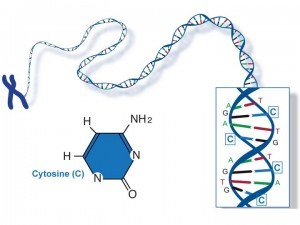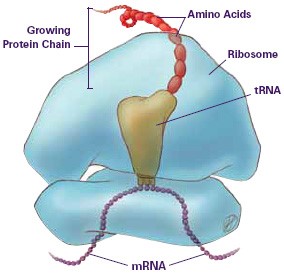
Leonardo da Vinci - Studies of the foetus in the womb.Wikimedia Commons BY 4.0
All living cells require some means of storing genetic information – instructions on how to generate progeny, replication, and how to build cells. The main principle of storing genetic information is having a blueprint – something that can be accessible easily and stable. Life on Earth uses DNA or deoxyribonucleic acid as a blueprint for storing genetic information. DNA carries information about genes – set of instruction of building blocks inside the cell (figure 1).

Figure 1. DNA stores genetic information inside cells. Wikimedia Commons CC BY 4.0
This information is extracted by RNA or ribonucleic acid and then transported to ribosomes to build functional units or proteins. DNA is composed of two chains and forms double-helical polymer made of nucleotides (stable structure for information storage). RNA is made of a single chain of nucleotides that is less stable, but more flexible to perform many functions – transport of genetic messages, helping to synthesize proteins, and catalyze reactions. This is a “central dogma” (figure 2) of information flow in molecular biology: from DNA to RNA (of from RNA to DNA and back in some viruses) to proteins.
Figure 2. Information flow in biological systems. Wikimedia Commons CC BY 4.0
DNA is a blueprint of life and it’s a simple polymer composed of repetitive four subunits (nucleotides). Each nucleotide is linked to each other in a chain. Two chains of nucleotides are like mirror images of each other and they are hold tight together due to electric interactions between chains. Any nucleotide has simple structure of a sugar (deoxyribose) attached to phosphate and a nucleic base (adenine, guanine, cytosine, and thymine or A, G, C, T). The code in DNA is linear where the sequence of nucleic is read by cellular internal machinery (figure 3).

Figure 3. Double helical polymer of DNA is made of nucleotides. The code is read in a linear fashion.Wikimedia Commons CC BY 4.0
RNA has many roles inside the cell including reading the information from DNA and participate in using this information for protein synthesis. RNA is usually made of a single chain of nucleotides “transcribed” from a region of DNA. A number of RNA molecules are mirror copies of specific parts of DNA in nucleus that are responsible for making new proteins, enzymes called genes. Gene is a sequence of DNA transcribed into RNA to make a new protein or a structure needed for cells to work. RNA nucleotides attached to each other in the same fashion as DNA, but the nucleotide thiamine doesn’t exist in RNA. There is uracil or U instead. RNA is transcribed from DNA by special enzymes called RNA polymerase inside the nucleus according to base pair rules: A-U, G-C (figure 4).
Figure 4. RNA is transcribed from DNA by RNA polymerase enzymes. Wikimedia Commons CC BY 4.0
Some RNA molecules destined for further use to synthesize proteins are called messenger-RNA or mRNA that leave the nucleus after transcription and move towards ribosomes – organelles that construct proteins from amino acids. Another type of RNA transports these amino acids (tRNA) according to the sequences brought by mRNA instructions to ribosomes. The little factories responsible for protein synthesis is a molecular machine that reads instructions and joins amino acids with help of another type of RNA called ribosomal RNA or rRNA (figure 5).

Figure 5. Ribosomes are organelles responsible for protein synthesis (translation of mRNA into proteins).Wikimedia Commons CC BY 4.0
Proteins are biological polymers with lots of different functions essential for cells to function. Instructions for protein synthesis is encoded in DNA. Since proteins are chains of amino acids (only 20 commonly used by human cells) of a particular sequence they can be easily reproduced from DNA through help of RNA. The information is encrypted in “triplets” inside genes – three nucleotides code for an amino acid as well as “start” and “stop” commands for ribosomes to use in the process called translation. Translation happens when ribosomes read information in mRNA and generate proteins (polypeptides) from corresponding amino acids (figure 6).
Figure 6. Genetic code used by mRNA where each three nucleotides (triplets) code for an aminoacid. Note that the start and stop codons are always present in mRNA and if transcribed with errors can ruin protein sequences. Wikimedia Commons CC BY 4.0
Gene mutations occur spontaneously during cellular division or under influence of mutagens leading to variations in DNA sequence. Mutations can bring advantageous traits passed in generations – like generation of more effective enzymes necessary for adaptation. Mutations can be silent, or small, or noticeable to detrimental. Consider the example of Down syndrome (figure 7) caused by mutations in chromosome 21 replication casing trisomy. The effect is a genetic disease causing mental development delays and increasing risk of other congenital abnormalities. Mutations can cause deletion of nucleic bases in DNA, insertion, substitution of the nucleotides or even piece and segments of chromosomes. Each human mature cell (except for gametes) carry 23 pair of chromosomes – 23 from mother and 23 from father (46 chromosomes) with 22 pairs being homologous (carry the same genes with different versions of each chromosome) and one pair of sex chromosomes. Some cells actively involved in cell division – gametes, stem cells, and regenerating cells are more prone to mutations and mutagenesis than mature cells.
Figure 7. Phenotype and karyotype representation of a child affected by Down syndrome.Wikimedia Commons CC BY 4.0
ДНК (дезокирибонуклеиновая кислота) является основной в хранении и передачи генетической информации в клетках. ДНК это полимер состоящий из нуклеотидов – аденинового (А), гуанинового (Г), Цитозинового (Ц), и Тиминового (Т). Основная функция ДНК – это хранение информации о строении белков и РНК (рибонуклеиновых кислот). У животных и растений молекула ДНК находится в ядрах клеткок, в специально упакованных хромосомах. Нуклеотиды ДНК состоят из пентозного сахара, фосфатной группы и азотистого основания. В пространстве ДНК представлена в виде двойной спирали. Азотистые основания – это аденин, гуанин, цитозин и тимин. Цепочки ДНК расподожены в зеркальном отношении по принципу комплиментарности базовых пар – гуанин с цитозином (Г-Ц), а аденин с тимином (А-Т). Именно порядок нуклеотидов определяет информацию о типах РНК, синтезе белков, и процессах жизнеделятельности клеток.
Каждая клетка человеческого организма несет огромное количество ДНК – 46 хромосом, которые содержат около 3 миллиардов базовых пар. Человеческие хромосомы являются гомологическими, где 23 хромосомы были получены от матери, и ровно 23 – от отца в процессе оплодотворения яйцеклетки сперматозоидом. Каждая клетка несет полный набор хромосом, идентичный по строению на 99.9%.
РНК состоит из рибозы, фосфат групп, и азотистых оснований – аденин, гуазин, цитозин, и урацил (в отличие от тимина находящегося в ДНК). РНК является уникальным переносчиков информации (мессенджер-РНК), а также может участвовать в процессе синтеза белков (транспортная-РНК и рибосомальная-РНК) и играть роль каталиста в некоторых клеточных процессах. РНК в отличие от ДНК всегда имеет вид одинарной цепочки нуклеотидов, которая образуется в процессе полимеризации благодаря ферментам РНК-полимераз в ядре клетки в процессе «транскрипции».
Центральная догма молекулярной биологии утверждает, что информации в живых системах может переходить из ДНК в РНК и обратно, и в конечном итоге превращаться в белки ( но никак обратно из белков в нуклиновые кислоты). Таким образом генетическая информации в живых клетках служит для формирования структурных элементов – белков. Белки это полимер, состоящие из 20 возможных амино кислот. Белки имеют различный размер, функции, строение, которые приобретаются в процесс синтреза и последующей модификаций. Синтез белков происходит в рибосомах – клеточных органеллах, которые осуществляют «трансляцию» информации из РНК в белки.
ДНК в клетке постоянно подвергается риску ошибок и изменения порядка нуклеотидов под воздействием физических факторов – радиация, и химических – мутагенными веществами. Все изменения в порядке ДНК, строении хромосом называются мутациями. Мутации являются важными элементами клеточной адаптации, огромную роль они играют в теории эволюции, но спонтанные и генетически мутации могут привести к таким заболеваниям как синром Дауна, или муковисцидоз. При синдроме Дауна происходит ошибка в формировании хромосного набора клеток, где хромосома 21 присутствует в тройном количестве – трисомия 21, что и приводит к ряду симптомов – замедление развития, порок сердца, и т.д.
| Содержание видео | |
| Качество видео | |
| Качество текста | |
| Я все понял 😎 | |
| Общая оценка урока |
leave your public comment or question, if you want